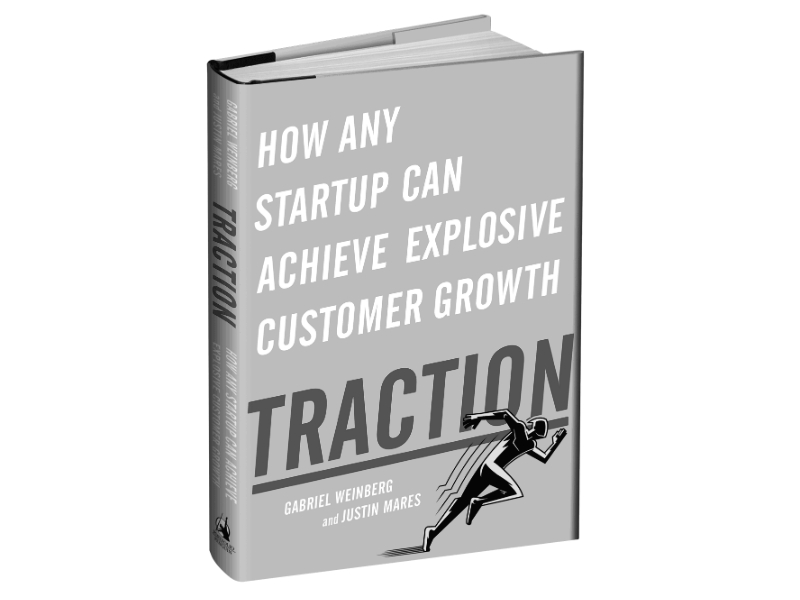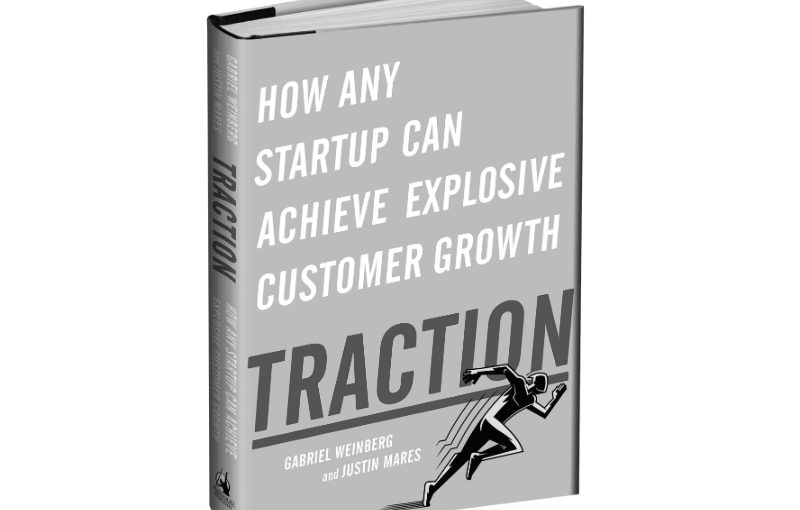One of my favorite marketing books to refer to for ideas is Traction: A startup guide to getting customers by Gabriel Weinberg and Justin Mares. Their first edition was also available as an audiobook on Audible. They are now in the process of publishing a 2015 second edition so I thought I’d take a moment to share some of my favorite parts of the book.

The idea behind the book is to derive practical lessons from how different startups have achieved their early growth. The book is probably the best window into the modern growth hacker style of marketing being practiced in startups today.
The Lean Analytics blog has a link to a sample pdf with the first 3 chapters and the book website has links to several more sample pdfs. To really get a taste of the depth and usefulness of the book I’ve pulled out a couple of my favorite excerpts below. The quotes below are pulled from the first edition, so be sure to check out the book website for the latest samples and chapter outlines.
Enter Gabriel and Justin…
Traction: A startup guide to getting customers
Chapter 1: Introduction
Before we get started, let’s define what traction is. Traction is a sign that your company is taking off. It’s obvious in your core metrics: if you have a mobile app, your download rate is growing rapidly. If you’re a search engine, your number of searches is skyrocketing. If a SaaS tool, your monthly revenue is blowing up. If a consumer app, your daily active users are increasing quickly. You get the point.
You can always get more traction. The whole point of a startup is to grow rapidly. Getting traction means moving your growth curve up and to the right as best you can. Paul Graham, founder of startup accelerator Y Combinator, puts it like this:
“A startup is a company designed to grow fast. Being newly founded does not in itself make a company a startup. Nor is it necessary for a startup to work on technology, or take venture funding, or have some sort of ‘exit.’ The only essential thing is growth. Everything else we associate with startups follows from growth.”
In other words, traction is growth. The pursuit of traction is what defines a startup.
Summary: Nineteen Traction Channels
After interviewing more than forty successful founders and researching countless more, we discovered that startups get traction through nineteen different channels. Many successful startups experimented with multiple channels (search engine marketing, business development, etc.) until they found one that worked.
We call these customer acquisition channels “traction channels”. These are marketing and distribution channels through which your startup can get traction: real users and customers.
We discovered two broad themes through our research:
- Most founders only consider using traction channels they’re already familiar with or think they should be using because of their type of product or company. This means that far too many startups focus on the same channels (search engine marketing, public relations) and ignore other promising ways to get traction.
- It’s hard to predict the channel that will work best. You can make educated guesses, but until you start running tests, it’s difficult to tell which channel is the best one for you right now.
When going through these traction channels try your best not to dismiss them as irrelevant for your company. Each traction channel has worked for startups of all kinds and in all different stages. Get one channel working that your competitors dismiss, and you can grow rapidly while they languish.
1. Viral Marketing
Viral marketing consists of growing your userbase by encouraging your users to refer other users. We interviewed Andrew Chen, a viral marketing expert and mentor at 500 Startups, for common viral techniques and the factors that have led to viral adoption in major startups. We also talked with Ashish Kundra of myZamana, who discussed using viral marketing to grow from 100k users to over 4 million in less than a year.
2. Public Relations
Public relations is the art of getting your name out there via traditional media outlets like newspapers, magazines and TV. We interviewed Jason Kincaid, former TechCrunch writer, about pitching media outlets, how to form relationships with reporters, and what most startups do wrong when it comes to PR. We also talked with Ryan Holiday, bestselling author of Trust Me, I’m Lying and media strategist, to learn how startups could leverage today’s rapidly changing media landscape to get traction.
3. Unconventional PR
Unconventional PR involves doing something exceptional (like publicity stunts) to draw media attention. This channel can also work by repeatedly going above and beyond for your customers. Alexis Ohanian told us some of the things he did to get (and keep) people talking about reddit and Hipmunk, two startups he co-founded.
4. Search Engine Marketing
Search engine marketing (SEM) allows companies to advertise to consumers searching on Google and other search engines. We interviewed Matthew Monahan of Inflection, the company behind Archives.com (before its $100 million acquisition by Ancestry.com) to learn how Archives relied primarily on SEM for their growth.
5. Social and Display Ads
Ads on popular sites like reddit, YouTube, Facebook, Twitter and hundreds of other niche sites can be a powerful and scalable way to reach new customers. We brought in Nikhil Sethi, founder of the social ad buying platform Adaptly, to talk with us about getting traction with social and display ads.
6. Offline Ads
Offline ads include TV spots, radio commercials, billboards, infomercials, newspaper and magazine ads, as well as flyers and other local advertisements. These ads reach demographics that are harder to target online, like seniors, less tech-savvy consumers and commuters. Few startups use this channel, which means there’s less competition for many of these audiences. We talked with Jason Cohen, founder of WPEngine and Smart Bear Software, about the offline ads he’s used to acquire customers.
7. Search Engine Optimization
Search engine optimization is the process of making sure your website shows up for key search results. We interviewed Rand Fishkin of Moz (the market leader in SEO software) to talk about best practices for getting traction with SEO. Patrick McKenzie, founder of Appointment Reminder, also explained to us how he uses SEO to cheaply acquire lots of highly targeted traffic.
8. Content Marketing
Many startups have blogs. However, most don’t use their blogs to get traction. We talked with Rick Perreault, founder of Unbounce, and OkCupid founder Sam Yagan to learn how their blogs transformed their businesses.
9. Email Marketing
Email marketing is one of the best ways to convert prospects while retaining and monetizing existing ones. For this chapter we interviewed Colin Nederkoorn, founder of email marketing startup Customer.io, to discuss how startups can get the most out this traction channel.
10. Engineering as Marketing
Using engineering resources to acquire customers is an underutilized way to get traction. Successful companies have built micro-sites, developed widgets, and created free tools that drive thousands of leads each month. We asked Dharmesh Shah, founder of Hubspot, to discuss how engineering as marketing has driven Hubspot’s growth to tens of thousands of customers through tools like their Marketing Grader.
11. Targeting Blogs
Popular startups like Codecademy, Mint, and reddit all got their start by targeting blogs. Noah Kagan, Mint’s former director of marketing, told us how he targeted niche blogs early on, and how this strategy allowed Mint to acquire 40,000 users before launching.
12. Business Development
Business development is the process of creating strategic relationships that benefit both your startup and your partner. Paul English, co-founder and CEO of Kayak.com, walked us through the impact of their early partnership with AOL. We also interviewed venture capitalist Chris Fralic, whose BD efforts at Half.com were a major factor in eBay’s $350 million acquisition of the company. We’ll show you how to structure deals, find strategic partners, build a business development pipeline, and approach potential partners.
13. Sales
Sales is primarily focused on creating processes to directly exchange product for dollars. We interviewed David Skok of Matrix Partners – someone who’s taken four different companies public – to get his perspective on how the best software companies are creating sustainable, scalable sales processes. We also take a look at how to find early customers and have winning sales conversations.
14. Affiliate Programs
Companies like Hostgator, GoDaddy and Sprout Social have robust affiliate programs that have allowed them to reach hundreds of thousands of customers in a cost-effective way. We interviewed Kristopher Jones, founder of the Pepperjam Affiliate network, to learn how a startup can leverage this channel. We also talked with Maneesh Sethi to learn how affiliate marketers choose what products to promote, and some of the strategies they use to do so.
15. Existing Platforms
Focusing on existing platforms means focusing your growth efforts on a mega-platform like Facebook, Twitter, or an App Store and getting some of their hundreds of millions of users to use your product. Alex Pachikov, on the founding team of Evernote, explained how their focus on Apple’s App Store generated millions of customers.
16. Trade Shows
Trade shows are a chance for companies in specific industries to show off their latest products. We interviewed Brian Riley of SlidePad, an innovative bike brake startup, to learn how they sealed a partnership that led to over 20,000 sales from one trade show and their approach to getting traction at each event.
17. Offline Events
Sponsoring or running offline events – from small meetups to large conferences – can be a primary way you get traction. We spoke with Rob Walling, founder and organizer of MicroConf, to talk about how to run a fantastic event, how it can benefit you, and the type of work that goes into pulling off a successful event.
18. Speaking Engagements
Eric Ries, author of the bestselling book The Lean Startup, told us how he used speaking engagements to hit the bestseller list within a week of the book’s launch, how he landed these talks, and why he chose to use this channel to generate awareness and book sales. We also interviewed Dan Martell, founder of Clarity, to learn how to leverage a speaking event, give an awesome talk and grow your startup’s profile at such speaking gigs.
19. Community Building
Companies like Zappos, Wikipedia, and Stack Exchange have all grown by forming passionate communities around their products. In our interview with Jimmy Wales of Wikipedia, he detailed how he built the Wikipedia community that’s created the largest repository of human knowledge in history.
Takeaways from the Nineteen Traction Channels
Every one of the nineteen traction channels has proven an effective means to get initial traction for both enterprise and consumer companies. It is hard to predict exactly which traction channel will be best for your company at a particular time. You have natural tendencies (bias) toward or against certain traction channels. Which traction channels are you biased for? Which traction channels are you biased against?
Chapter 2: Traction Thinking
If you’re starting a company, chances are you can build a product. Almost every failed startup has a product. What failed startups don’t have are enough customers. Marc Andreessen, founder of Netscape and Venture Capital firm Andreessen-Horowitz, sums up this common problem:
“The number one reason that we pass on entrepreneurs we’d otherwise like to back is their focusing on product to the exclusion of everything else. Many entrepreneurs who build great products simply don’t have a good distribution strategy. Even worse is when they insist that they don’t need one, or call [their] no distribution strategy a ‘viral marketing strategy’.”
A common story goes like this: founders build something people want by following a sound product development strategy. They spend their time building new features based on what early users say they want.
Then, when they think they are ready, they launch, take stabs at getting more users, only to become frustrated when customers don’t flock to them.
Having a product your early customers love but no clear way to get more traction is frustrating. To address this frustration, spend your time building product and testing traction channels – in parallel.
Building something people want is required for traction, but isn’t enough. There are many situations where you could build something people want, but still not end up with a viable business.
Chapter 3: Bullseye Framework
With so many channels to consider, figuring out which one to focus on is tough. That’s why we’ve created a simple framework called Bullseye that will help you find the channel that will get you traction. As billionaire PayPal founder and early Facebook investor Peter Thiel put it:
“[You] probably won’t have a bunch of equally good distribution strategies. Engineers frequently fall victim to this because they do not understand distribution. Since they don’t know what works, and haven’t thought about it, they try some sales, BD, advertising, and viral marketing—everything but the kitchen sink. That is a really bad idea. It is very likely that one channel is optimal. Most businesses actually get zero distribution channels to work. Poor distribution—not product—is the number one cause of failure. If you can get even a single distribution channel to work, you have great business. If you try for several but don’t nail one, you’re finished. So it’s worth thinking really hard about finding the single best distribution channel.”
Chapter 4: Testing out Traction Channels
The testing step is where you put your ideas into the real world. The goal of this step is to find out which of the traction channels is worth focusing on. You will make that decision based on results from a series of relatively cheap tests. These tests should be designed to answer the following questions.
- Roughly how much will it cost to acquire customers through this channel?
- How many customers do you think are available through this channel?
- Are the customers that you are getting through this channel the ones that you want right now?
Chapter 5: Moving the Needle
Your traction strategy should always be focused on moving the needle for your company. By moving the needle, we mean focusing on marketing activities that result in a measurable, significant impact on your company. It should be something that advances your user acquisition goals in a meaningful way, not something that would be just a blip even if it worked.
From the perspective of getting traction, you can think about working on a product in three phases:
- Phase I – Making something people want
- Phase II – Marketing something people want
- Phase III – Scaling your business
At different product phases, moving the needle means different things. In phase I, it’s getting those first few customers. In phase II, it is getting enough customers where you’re knocking on the door of sustainability. And, in phase III, your focus is on increasing your earnings, scaling your marketing channels, and creating a truly sustainable business.
Some traction channels will move the needle early on, but will fail to work later. Others are hard to get working in phase I, but are major sources of traction in the later phases (PR is a good example). On the other hand, some channels will be great in phase I but useless in phases II and III because they simply don’t have the volume required to move the needle.
To read the the full book, check it out on Kindle and paperback on Amazon.
The second edition of Traction has a new subtitle, Traction: How any startup can achieve explosive customer growth. Personally, I quite liked the old subtitle, but the book is absolutely awesome and the relaunch of the new edition will take the material to a whole new audience.

You can also check out the authors at their Traction Book Website and they have a great series of articles about Traction on the blogging platform Medium. The audiobook of the first edition was excellent, so I’m also looking forwards to the relaunch of the audiobook for the second edition.
